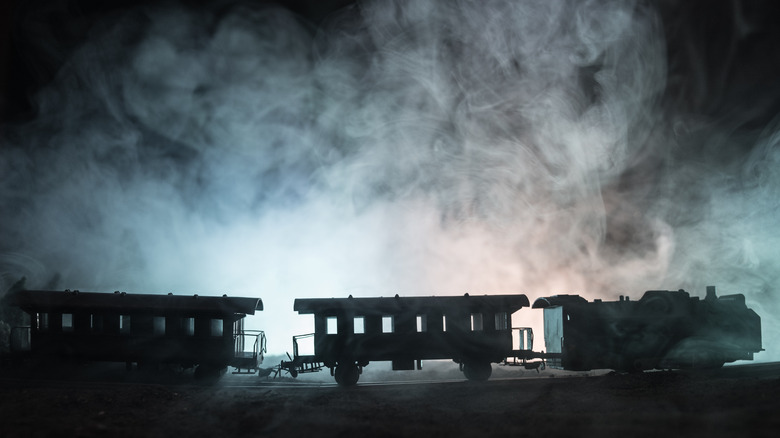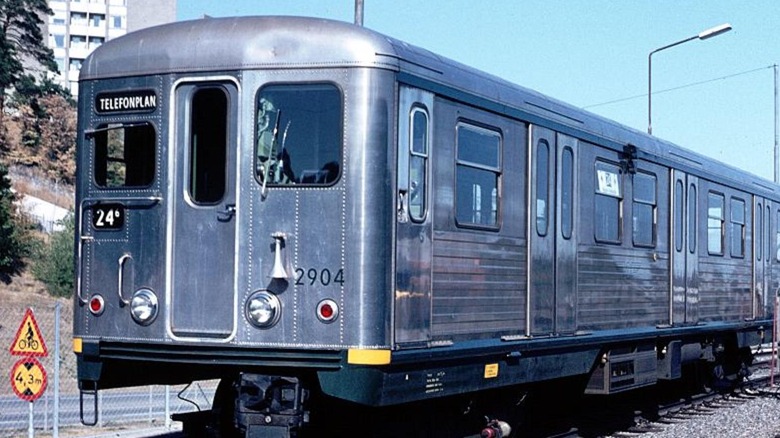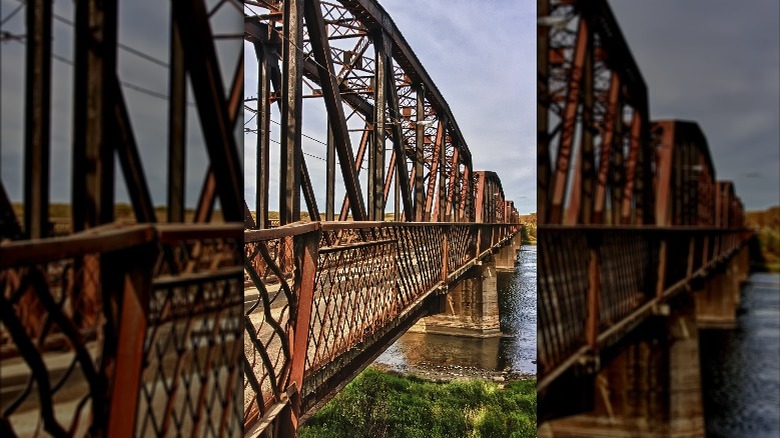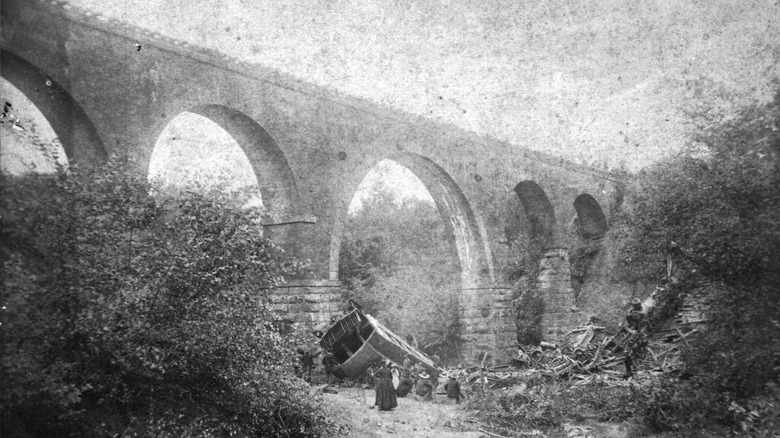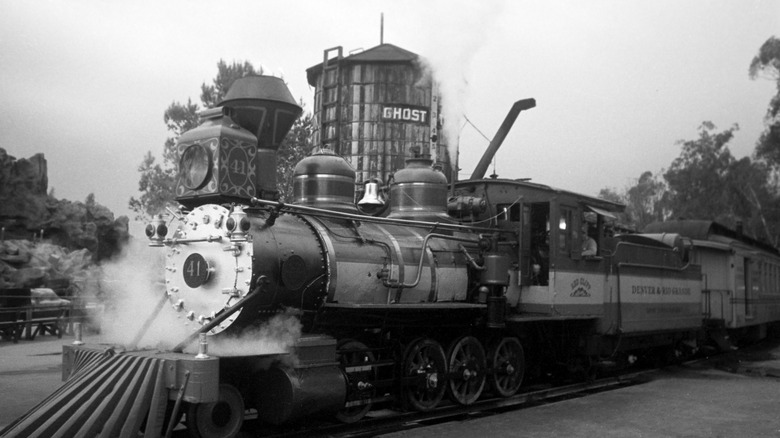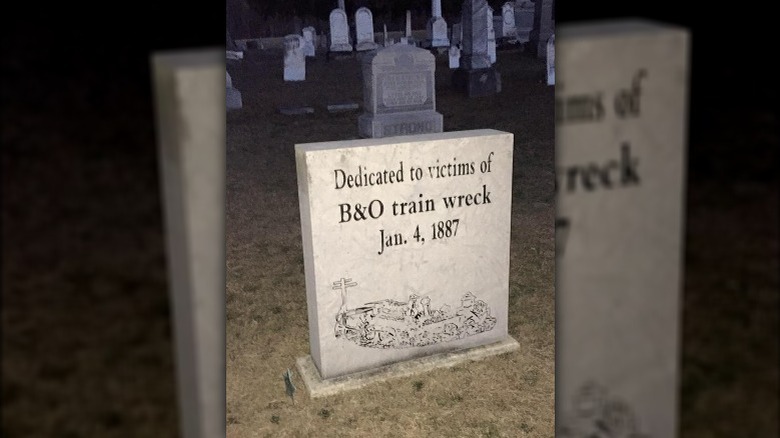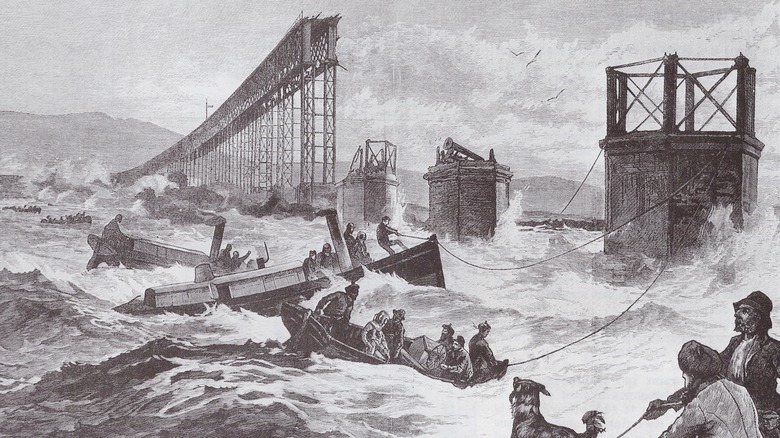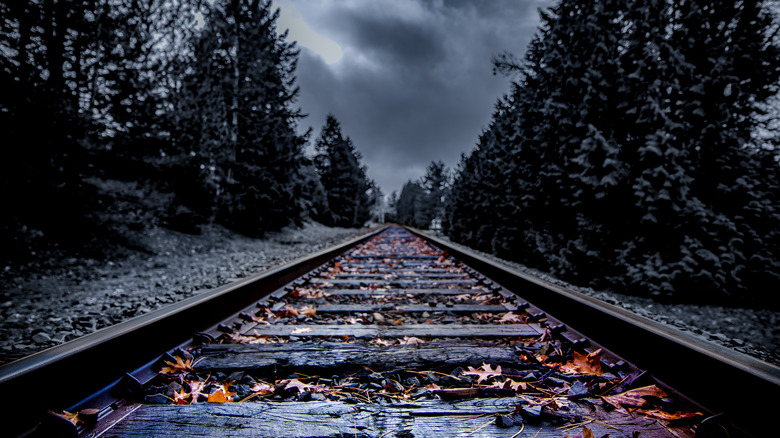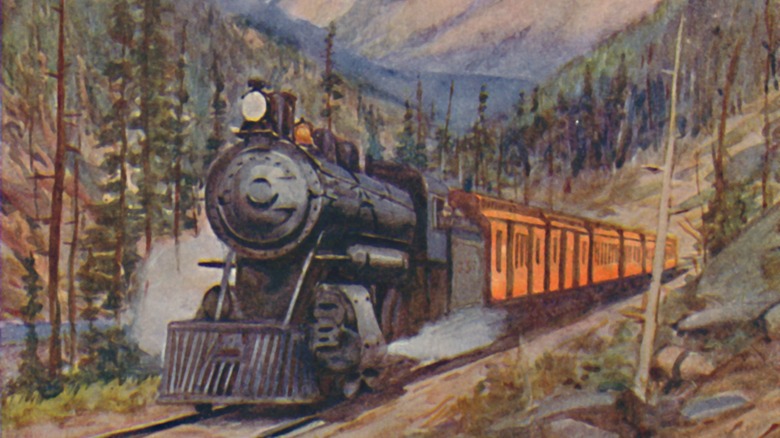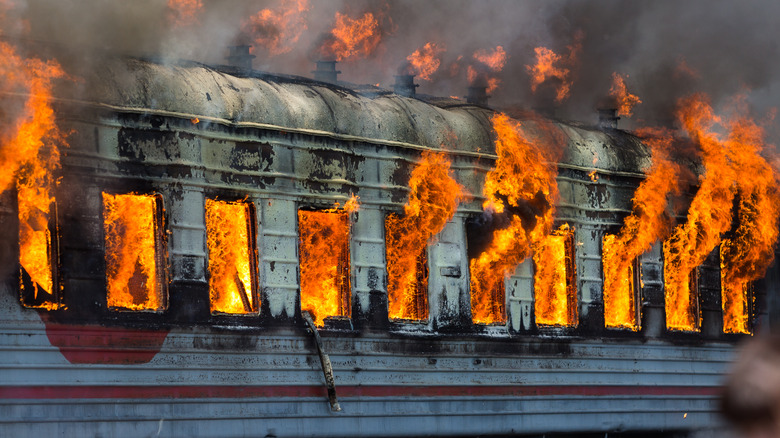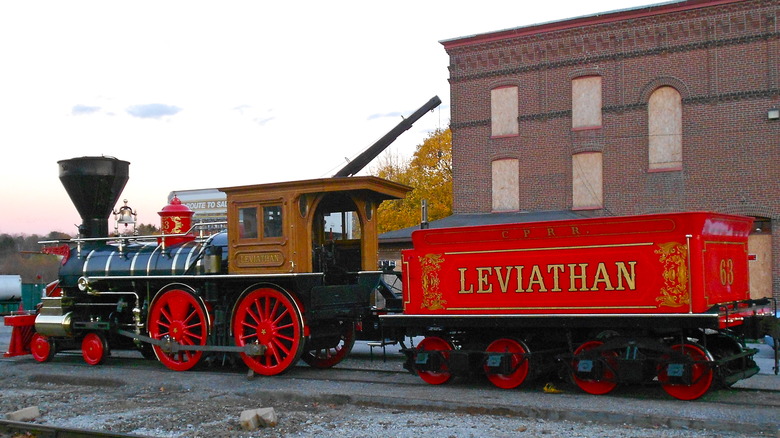Ghost Trains Around The World (Including Lincoln's Funeral Train)
Legends of ghosts from around the world include a wide variety of spectral phenomena, from ladies in white gowns to phantom hitchhikers to even the spirits of animals like dogs or pigs or what-have-you. But whether poltergeist or vengeful spirit or electronic voice phenomenon, most hauntings involve the spirit of a living being (with the exception of things like Japanese tsukumogami, which is a whole other kettle of fish). The phenomenon of ghost trains, however, is one where the ghost isn't a person, it's a ... well, it's a train.
In many ghost train stories, the phantom locomotives are echoes of tragic railway accidents, or they're mysterious engines that carry unsuspecting passengers off into parts unknown. While the term "ghost train" is used to refer to real-life trains that run along the lines without passengers to keep the track clear, the trains in these stories are thought to be actual, literal ghosts (though sometimes they're both). Here are the stories of a few of the most famous ghost trains, plus some haunted tracks and stations for a bit of variety.
Stockholm's Silverpilen
Stockholm, Sweden's Silverpilen ("The Silver Arrow") is one of the most famous ghost trains in the world, and an example where the train of legend absolutely did exist. Silverpilen was one of a handful of experimental unpainted aluminum trains tested out on Stockholm's metro line in the 1960s to see if these more cheaply produced trains could save the transit system money. The eerie look of its unadorned exterior and its slightly altered design were disagreeable to passengers, and the fact that the strange silver train seemed to turn up at random meant that legends soon grew up around it. Before long, the people of Stockholm would tell stories that if you got on Silverpilen, it would never stop, and you would be doomed to ride it for eternity. Or it only stops once a year and its passengers are the souls of the dead.
By the 1970s, the story of Silverpilen got combined with ghost stories surrounding an unused train station called Kymlinge, where it was said that only the dead got off the train. Kymlinge then became Silverpilen's home station, where it picked up and dropped off the dead. Silverpilen was decommissioned in the 1990s, though a couple of its cars are still in use on other trains. Nevertheless, stories of sightings of a ghostly silver train are still common among the people of Stockholm.
St. Louis Light of Saskatchewan
Perhaps the best-known spectral locomotive in Canada is the St. Louis Ghost Train, also known as the St. Louis Light, a phenomenon from just north of St. Louis, Saskatchewan, that is very familiar to locals. For generations, walking out along the track and watching for the ghost light has been a common pastime for St. Louis teenagers. Those who claim to have witnessed this phenomenon say that a white light appears along the railroad track, sometimes accompanied by a red light that moves and circles around the white light, barreling through the night air before disappearing when it reaches the bush line.
One variant of the legend that has arisen around this eerie light is that in the 1920s a conductor was inspecting this stretch of tracks, only to be decapitated by a passing train. Presumably, the apparition is some kind of residual energy from that tragic event.
Unfortunately, record-keeping doesn't go far enough back to confirm the story of the beheaded conductor, so we may never know how much truth there is to that legend. Additionally, the land where the railroad once ran is now private property, and the tracks are long gone. Despite that, thrillseekers say the light can still be seen where the track used to be. Skeptics say the light isn't a phantom train, just car headlights from a nearby road, but for now, the mystery remains.
Ghost train of Iredell County
While many stories of ghost trains arise strictly from the realms of legend and speculation, the phantom train of Iredell County in North Carolina starts with a real-life tragedy. In August of 1821, a train just west of the town of Statesville fell into the ravine under Bostian Bridge after derailing from the 60-foot-high trestle. The train was pulling six cars, including several passenger cars, and while there were survivors who managed to escape the wreckage at the bottom of the bridge, the train disaster ultimately took the lives of 23 people, making it one of the deadliest train wrecks in the history of North Carolina.
According to legend, 50 years to the day after that fateful crash, a car stalled out in viewing distance of the crash site. The driver went to find help, leaving his wife to watch the car. When the clock ticked to the exact time of the wreck, the wife saw a ghostly echo of the derailment right before her eyes, including the shrieks of the dying as the train splashed into the creek below.
In a tragic echo of this story that is all too real, a ghost hunter lost his life in 2010 on the disaster's anniversary while trying to see the phantom train. He was hit and killed while saving his girlfriend from a very real oncoming train.
Madrid's haunted metro
It's not only the trains themselves that appear as phantoms in railway lore. Many large cities have sprawling metro lines that stretch like spider webs under the city streets. With that many miles of often dark or poorly lit underground tunnels, it's only natural that some urban legends would pop up about these train lines and the various stations and stops that dot the transit map. Madrid, for example, has the seventh-biggest metro line in the world, and according to Midnight Trains, those 183 miles of track are jam-packed with ghosts.
One of the most famous is the station at Tirso de Molina, where people say they can hear the cries and groans of the dead from under the platforms. Allegedly, construction workers uncovered the bodies of several monks from an old monastery that had stood on the spot and hastily reburied the bones under the platforms rather than giving them a proper rest. The same station is a setting for a tale where a woman found herself accompanied by three ghostly passengers in the car with her. The Santiago Bernabéu station used to be known as Lima station, and legend says the reason is that people were known to get lost in its tunnels and emerge across the globe in Lima, Peru. But don't worry: there's a phantom train, too, which carries the souls of the damned along the city's line 5 to the realm of the dead.
[Featured image by Currybet via Wikimedia Commons | Cropped and scaled | CC BY-SA 2.0]
Arizona Shadow Train
Folklorist S. E. Schlosser records a legend from Arizona in which an old prospector finds himself lost with no water out in the desert flats while searching for a claim, ultimately passing out from the heat and sun. He wakes up an unknown amount of time later to the hissing sound of a steam train chugging through the torrid air. The miner is confused, as he is far from any town, but then he remembers hearing stories when he was young of a shadow train that rushes through the desert with no track like a black smear across the cloudless sky. As the black train speeds toward where he lies, too weak to move despite the engine's warning whistles, the miner realizes these stories were no legend. The train stops inches from his head, and the conductor and a passenger carry him on board just before he passes out again.
He reawakens in a sheriff's office in a town he doesn't know, being offered water by a lawman who says he found the miner lying almost dead five miles out of town. When he asks if the train had left him there, the confused sheriff tells him that there's no train that runs through that area. To this day, people claim they see the shadow train screaming through the midday sun out in the desert, still running without a track.
Republic Ghost Train
Another phantom train inspired by a very real historic tragedy is the Republic Ghost Train in Seneca County, Ohio. In January 1887, a passenger train carrying 65 people aboard collided in the dark of night with a stalled freight train near the small town of Republic. The train had been traveling at 60 miles per hour, so by the time the engineer saw the stopped train on the tracks ahead of him, it was too late to stop. The engineer jumped from the train and the two engines smashed into each other with a deafening crash. Several of the passenger cars collapsed into each other, including the smoker car, where a fire started that soon killed at least 15 people. The overall number of deaths from the crash is unknown, but it was likely as many as 22 people. Fortunately, the passengers in the sleeper cars survived because someone managed to uncouple them from the other cars and push them away from the burning wreckage.
Since that time, locals have repeated the legend that on some nights you can look down the track and see the ghost train, an echo of the 1887 disaster, barreling down the tracks. Its lights will flash throughout Seneca County when the spectral locomotive passes by the cemetery where the victims of the disaster who were never identified are buried (pictured, via the Seneca County Historical Society Facebook page).
Ghost train of Tay Rail Bridge
The Tay Rail Bridge was completed in 1877 after six years of construction to cross the Firth of Tay, an estuary in eastern Scotland where the River Tay empties between the cities of Perth and Dundee. The bridge served to connect the railway between Dundee and Fife in the northeast. Like in many stories of ghost trains, the Tay Bridge is remembered for a deadly railway disaster.
Just two years after the completion of the bridge, disaster struck in what became one of the worst train accidents in Scottish history. A train carrying 75 passengers was crossing the firth when a storm struck, causing the middle section of the bridge to collapse. The crew and passengers were all plunged into the cold winter waters below, leaving no survivors and nearly half the bodies never found.
A second bridge was opened right next to the ruins of the old one a few years later that is still being used to this day. The ruined pillars of the old line can still be seen rising out of the water next to the new bridge. Likewise, it is said that on the anniversary of the disaster, a ghost train appears floating where the old track once stood. The ghostly train repeats its disastrous plummet into the waters, with the screaming voices of the spirits of the dead passengers audible the whole way down.
Virginia's Cohoke Light
King William County in Virginia is home to a mysterious ghost train phenomenon known as the Cohoke Light, so called because the apparition is generally spotted at the railroad crossing on Mt. Olive Cohoke Road. As with other ghost train phenomena, witnesses claim to have seen an otherwise unexplained light coming down the tracks, swinging back and forth, sometimes obscured by the treeline. Historians say that sightings of the Cohoke Light date back to at least the 1950s, which unfortunately works against the legendary claims that the ghost train has its origins in the 19th century.
There are two main explanations for the appearance of the shining light on the tracks in King William County: The first is very similar to stories of the St. Louis Light, saying that a railway worker was decapitated in an accident 100+ years ago, and the light is his lantern swaying as he searches for his lost head. The second says that it's the lamp of a Confederate train carrying wounded soldiers that never reached its destination because it was ambushed by Union troops. Unfortunately, neither of these stories is supported (and in fact, both are contradicted) by the historical record, which only has relatively minor accidents occurring at that crossing, like a derailment with one injury and a single automobile collision. Additionally, any Confederate train carrying wounded soldiers would have been headed in the other direction.
Phantom Train of Medicine Hat
Most tales of ghost trains involve individuals on foot or in a car witnessing a spectral locomotive speeding past them or even away from them. But the best-known legend of the Phantom Train of Medicine Hat, Alberta, involves a near collision with another train. According to the story related by workers from the Canadian Pacific Railway, in 1908 a train headed east rounded a bend only to find itself face-to-face with an oncoming train headed west. Even though it was too late to brake, there was no crash, as the oncoming train veered off into the empty air, with ghostly crew members waving to the living crew as they flew into the ether.
Fearing that this vision was a premonition of his death, Bob Twohey, the engineer, went to visit a fortune teller who told him that indeed he was soon to die (some versions say he learned this before seeing the phantom train). Hoping to avoid his fate, Twohey refused to drive that same train on that same route again. Another engineer took over the route and also saw the phantom train. On July 8, 1908, that same engineer took that same train on the same route despite the ghostly warning. This time when the train rounded that same bend and encountered an onrushing train, it wasn't a phantom. It was a very real passenger train, driven by Bob Twohey. Every man who had seen the phantom train died on impact.
Express train to Hell
Another story collected by S.E. Schlosser is a haunted train tale set in Newark, New Jersey, at the central station in that city. The tale focuses on the stationmaster, who is trying to calm down what appears to be an old vagabond running about his station and wailing. When the stationmaster talks to him, the old man claims that the Express Train to Hell is coming for him because he once killed a man who had cheated him at cards. The stationmaster, perhaps reasonably, assumes the old man is unwell and tries to shake off the troubling sound of his pleas for help.
Just before midnight, however, the sound of a steam train chugging through the night air approaches, sounding as if it has no intention of stopping. The stationmaster is confused, as the next train isn't scheduled until after midnight. Despite the loud sound of the engine, the scream of the whistle, and the rushing wind of a passing train, the stationmaster doesn't see anything traveling through the station. As he tries to pull the old man away from the tracks and to safety, the old man gives one terrible final wail and vanishes from the stationmaster's grip without a trace. It turns out the Express Train to Hell had in fact come for him, and it came dead-on midnight.
Lincoln's funeral train
Probably the most famous ghost train of them all is Abraham Lincoln's funeral train, sightings of which have been reported many times around the route of the historic funeral train near the anniversary of Lincoln's death. In April 1865, following the assassination of the president, his body was taken by rail from Washington, D.C., to Lincoln's hometown of Springfield, Illinois, via New York City so that Americans along the way could mourn him. Ever since, on or around the anniversary of that initial rail journey, people have claimed to have witnessed a spectral echo of the funeral train between New York and Springfield.
While many ghost trains are described as simple lights or dark smudges, witnesses of Lincoln's funeral train have reported a number of spooky details. People claim that they can see inside the train an entire rail crew made up of skeletons, including a band playing silent dirges for the lost president. In the back half of the train is a flatcar that carries Lincoln's coffin, encircled by skeletons in Union Army coats. As the train passes, all clocks and watches stop until it has disappeared, usually leaving them six minutes slow. Others say the train pulls along with it darkness, cold, and clouds. The train has been sighted all over New York State, including in Grand Central Station, which hadn't even been built yet at the time of Lincoln's funeral.
